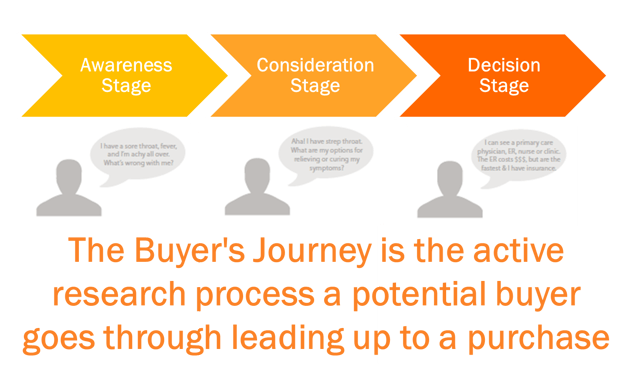Whether you're new to content marketing or just trying to revamp and improve your content marketing efforts, this guide will give you all of the information you need to succeed at content marketing in 2016!
Not only have I shared my own knowledge and experience with you, but I've also spent literally days gathering the best and newest information on all aspects of content marketing from all over the web, which you'll find linked throughout this post. Many of these links go into great detail on the subjects I cover in this post, they're definitely worth a read if you're looking for a deeper dive into what's covered in this guide.
If you found this guide helpful, please do me (and a fellow content marketer) a favor and share it with someone you know who could benefit from the information. If you have any questions about what's covered in this guide or any other aspect of digital marketing, feel free to leave them in the comments of this blog post and I'll reach out here to answer them.
WHAT IS CONTENT MARKETING AND HOW DOES IT WORK?
Content marketing is part of the inbound marketing philosophy. The idea behind inbound marketing is to create great content that will bring your customers to you through online searches and people sharing your content with each other. This is in stark contrast to traditional, interruptive marketing, like commercials, online ads, and cold sales calls.
Rather than interrupting prospects when it's not convenient for them or when they're not even looking for your product or service, you instead create content that helps a prospective customer who is actively seeking information about the product or service you offer through the stages of the buyer's journey.
 Image Credit: HubSpot Academy (Podcast - togo.fm)
Image Credit: HubSpot Academy (Podcast - togo.fm)
In this way, rather than being an interruptive nuisance, you are instead viewed as a helpful, knowledgeable source of information in helping them to make an informed decision to purchase, ideally from you.
The content you write brings traffic to your website, with your educational and informative blog posts, videos, podcasts, etc giving prospective and existing customers a positive reason to follow and interact with you.
Premium content offers such as newsletters, ebooks, whitepapers, etc are offered along with your blog content. To gain access to this valuable additional information, prospects trade some information about themselves (typically name, email address, and maybe job title, but you can ask for more if the content offer is worth it) in exchange for free access to this premium content.
When a prospect completes a form on a landing page to receive a piece of premium content, they become a lead. Over time you will continue to send these leads more information that they might find useful, typically in a monthly or weekly newsletter, with the goal of converting these leads into sales.
Now that we understand content marketing and the process behind it, we'll talk about what it takes to be successful as a content marketer.
WHAT DO YOU NEED TO SUCCEED AT CONTENT MARKETING?
PERSONAS

If you want to be a successful content marketer, you're going to need to start by understanding who your audience is and what they care about. There's not much point in writing if the people you're trying to reach won't be interested in what you've written.
You can accomplish this through the use of personas. A persona is a fictional representation of a certain segment of your target audience, usually that target is your ideal customer, but that can depend on what your goals are.
How do I learn more about my audience and build effective personas?
At the beginning it seems like a very daunting process that is easy to be intimidated by ("I gazed long into the blank page... and the blank page gazed back into me."), but I've made a handy guide and worksheet that makes it easy, so now you don't have to face a blank page on your own.
You can find this resource and several more for creating your personas in my free ebook, Facebook Basics: How to Target Great Facebook Posts.
To summarize the process quickly for you, here are the 3 simple steps.
- Figure out who your ideal customer is. (I also provide a worksheet that helps you figure this out).
- Do some basic research on this group (I offer sources and methods to help you with this).
- Fill this information into your own persona, using the persona checklist and the example persona as a helpful guide.
You can also find more great information on how to create your buyer personas from Hubspot's blog post, which also includes a helpful template. That's easy enough, right? After you've completed these three steps, you'll now have an idea of who you're writing for and what you should be writing to appeal to your target audience.
A STEADY STREAM OF GREAT CONTENT

This one seems pretty obvious, but it's actually one of the most difficult parts of content marketing. Everyone from small "mom and pop" businesses to huge multinational corporations struggle with how they will consistently produce great content that is worth reading.
One "secret" that many find is that you don't necessarily have to blog every single day in order to see results, so if you can't start your journey into content marketing at the helm of a well-oiled content machine, it doesn't mean you should just give up.
It's okay to write great content at a slower pace, just keep in mind that the slower and less consistent you are in producing your content, the longer it will be before you see results.
How often should you ideally be blogging?
There's a lot of contention in the industry on how often you should be creating new content, but according to Moz's Guide to Blogging, "You certainly don't need to blog every day, or even every week for that matter."
We agree that finding the right posting frequency for you and your audience is more important than trying to post at an unsustainable rate.
From the takeaways of John Maver's post on the posting schedule experiment Hubspot and Moz collaborated on last year, we can learn that you should:
- Find your own benchmarks. How many posts per week are you doing on average now? What is your average traffic level, engagement, and conversion rate per post?
- Increase your output. Do a 2-week test where you publish up to twice as much content. Perhaps you can reuse/update some older posts that are still relevant to make up the difference.
- Decrease your output. Do a 2-week test where you publish only high-value content, but less frequently.
- Run the numbers. Measure the effects of each test - conversion rate/post, weekly traffic, and engagement/post. Look at where your traffic came from - social, direct, referral, search - and see how those platforms changed with the tests.
- Update your "normal". Based on the data, see whether making a change to the normal schedule makes sense. Look at how much effort it takes to publish a post versus the value each additional post brings in. Also, like Moz, see if the extra time from a lower volume schedule can be put to better use elsewhere.
DISTRIBUTION

"Build it and you'll be waiting forever for them to come." It's not enough to understand your audience and write great content for them, nobody knows you're writing that great content yet! You're like the great hole in the wall restaurant that makes the best food in town, but nobody knows you exist.
You need distribution.
Whether that is posting on social media, SEO, partnering with influencers who will share your content, or something else, you have to find some method of spreading your content to the masses that works for you and fits your target audience (yes, this is where those personas that help you know who your target audience is, what they care about, and where they live online come to your rescue again, because that's how the persona do.)
Each of these distribution methods have their strengths and weaknesses. Ideally you'll use a mix of them that is tailored to the audience you're trying to reach:
Social Media
Most platforms have strong targeting capabilities and a built in advertising platform. Earlier this week AdWeek reported that 28% of time spent online is on social media sites. Between the major platforms and the niche groups within them, and other smaller sites that target only a specific niche, you're likely to be able to find almost any target audience on social media.
- Facebook - It's currently the largest social media network, with 1.59 Billion monthly users, according to yesterday's community update from Mark Zuckerberg. There are a lot of options for targeting the right audience you want to reach.
- The downside of course is that with organic reach lower than ever before the platform has shifted away from providing free access to most of your fan's News Feeds and is now very much pay to play. You can expect to need to promote your content on Facebook in order to reach and grow a targeted audience, and again in order to continue to reach the people who have already liked your page.
- Why should you be willing to put up with this? Because Facebook can drive a ton of traffic to your blog content, in fact it has overtaken Google as the top referrer of traffic to other websites.
- Twitter - Twitter can be very effective for both B2B and B2C brands. Twitter forces you to keep your messaging short (at least for now), which is great for mobile. Of course, what's great for mobile is great for your social media presence, considering that 80% of Twitter users access Twitter via mobile, 47% of Facebook users only login from mobile, and 80% of all online search traffic is mobile!
- Twitter is very effective for social outreach, basically that's the process of finding people on social who are talking about your brand, your industry, a specific piece of content, a problem with your product or service, or anything else that matters to you, and getting involved in those conversations. This can lead to amazing things, like proactive customer service, where you discover people who never came to customer support or already had a bad experience with other support channels talking about problems they've had with your business, that you can help them solve. Buzzsumo has a great post with advice from 15 digital marketers on how you can develop a great social outreach strategy.
- Something to be aware of, in my experience Twitter's ad platform is quite a bit weaker than LinkedIn and Facebook, especially for B2B brands, for two reasons.
- The first reason impacts B2B brands the hardest, and that's the very limited options for targeting people who work in specific industries or hold specific titles. Targeting people by job function is much more difficult on Twitter than it is on LinkedIn and even Facebook.
- The second issue is a problem for everyone, it's very easy to accidentally expand your Twitter ad targeting to include audiences you didn't intend when you're actually trying to make it smaller and more targeted. Many of Twitter's ad targeting options that would be an "and" option on other platforms (for example, I want to reach people who live in Texas and are between 18 - 24) will actually be an "or" option in Twitter's ad targeting.
- If you changed the "and" in the previous example to an "or," instead of reaching only people who live in Texas between the ages of 18 - 24, you would actually expand your targeting to include all people who live in Texas (regardless of age) and all people between the ages of 18 - 24 (regardless of location). Rather than reigning in your targeting to reach a very specific group, you actually would just separately target two huge groups you didn't intend to. If you know to watch out for this you can avoid this problem, but if you're new to Twitter ads, have experience with how the Facebook and LinkedIn ad platforms' targeting options work, and aren't paying close enough attention, this mistake could be easy to miss.
- LinkedIn - LinkedIn is great for when you need to reach people who work in a certain industry. Companies who sell to other companies (B2B) will most often take advantage of LinkedIn, though there are certainly some great use cases for B2C companies as well.LinkedIn has incredibly powerful targeting, with options as wide as industry or seniority and as granular as job title or people who work at specific companies.
- I've also used LinkedIn to verify my ad targeting on other platforms when building B2B communities on Facebook or Twitter, by looking up the people who begin interacting with content through Facebook and Twitter ads on LinkedIn to make sure they fit the audience I was trying to reach.
- So what's the catch? Running ads on LinkedIn is really expensive. It can also take a long time to get your ads reviewed, because unlike Facebook and Twitter's automated review process, every ad is reviewed manually by a person. This can be a real bummer if you need to get a short campaign up quickly without a lot of notice. The old adage "you get what you pay for" definitely applies though. For B2B brands traffic coming from LinkedIn tends to be more qualified, leading to more time spent on the landing page and more conversions and leads.
- YouTube - YouTube is the most popular video hosting platform in the world, with over 1 Billion users their videos reach more people between the ages of 18 - 49 than any cable network in the US. YouTube also has an advertising platform that can help you get your video content in front of your target audience. You can also post links to your videos on other social platforms and promote them there using Facebook, Twitter, or LinkedIn ads to drive more targeted traffic to your video content.
- So what potential issues do you need to be aware of? Facebook seems to view video content as an area of interest. Facebook videos currently get well over 100%x more reach than a post with a photo in it, and videos are automatically played in the News Feed. This means that if you're trying to reach people on Facebook with your video, uploading it directly to their platform will probably provide better results than linking to your YouTube video in a Facebook post.
- Niche Platforms - There are just tons of social media networks out there. You're probably familiar with the biggest platforms already, but there are many smaller niche sites that might be worth looking into. Whether they focus on a particular hobby or industry, there's a good chance that there's a niche online community that relates to your business that you may want to get involved in. These are less likely to have their own robust advertising platforms and as smaller, sometimes more insular communities, they may resent a brand coming in and advertising at them in their favorite online space.
- The correct way to approach these platforms is to interact as a member of the community, contributing content and advice in a way that is helpful and definitely not "salesy." Talk about the focus of the community, not yourself, and interact with what other people are posting, don't just spam the community, even with useful content. Truly become a pillar of the community, and act like a person, not a brand.
Search Engine Optimization
Search Engine Optimization (SEO) is another very important tool in your toolbox. It's how people who haven't heard of you or read any of your content yet will find you when they're searching for information online related to what you're writing about. Properly implemented SEO tactics will make you easier to find online.
Here are a few best practices that you should keep in mind:
- Your Content - When writing your content, think of what your persona (your ideal customer) wants to learn about. What information would they search for that might lead them to you? The first pieces of content you write should address questions that a new or prospective customer might have.
- Remember, right now you should be focused on answering questions about your product or services, and not talking so much about yourself and your business. The goal is to establish expertise by demonstrating knowledge, not by self promoting your business by talking about how many years you've been in the industry, what awards you've won, etc.
- Your Keywords - Focus on keywords that are related to the core topics you want to focus on. Moz has a great blog post that walks you through how to do proper keyword research that will help you determine if a keyword is right for you. You'll want to write content that includes these keywords, but you will want to avoid tactics like keyword stuffing (explained below), that could cause Google to ding your SERP rankings - quite the opposite of what you're going for.
- Inbound Links - Inbound links are content that other people have written that links back to content you have written. Having more inbound links to your content demonstrates to search engines that you have a high authority on the topic you're writing about. These inbound links are an important factor in elevating your search rankings. Hubspot has a great list of 32 ways to grow your inbound links.
- Avoid Blackhat Tactics - Blackhat tactics are any practice which seeks to manipulate search rankings by exploiting the algorithms that rank search results to artificially inflate the SERP ranking of a page, blog, or website. There are many such deceptive practices that you should avoid, if you're caught leveraging any of these, it could lead to anything from a lower search ranking to having your website banned from Google's search index.
- Keyword Stuffing - Keyword stuffing is the practice of repeating keywords in an unnatural way over and over in an attempt to engineer a higher SERP ranking for a page. Google has some great examples of what not to do. This tactic just isn't effective, and is actually likely to hurt your search rankings.
- Comment Spam - Spamming links to your blog in other people's blog comments isn't just distasteful, it's also not getting your anywhere. Most comment sections add a [no follow] tag to links in the comments section, so you're just alienating people who might have actually wanted to link to you and having no impact on your search rankings.
- Link Farming - It can be tempting to pay to have someone link to your content to get those coveted inbound links, or just create your own series of website that link to each other to build credibility, but Google is no fool. Google doesn't approve of link building schemes of any sort, and according to Google these will "negatively impact a site's ranking in search results."
WHEN SHOULD I EXPECT TO SEE RESULTS?
The short answer is "it depends." As CopyBlogger aptly points out, content marketing is a long game. There are a lot of factors to consider, but we'll cover a few of the key elements that will most commonly affect how quickly new content marketers start seeing real results.
If you follow the recommendations laid out below, you can expect to post 15 times per month on a consistent basis, and should start seeing results in both increased traffic and leads after 7 - 10 months.
POSTING FREQUENCY

Arnie Kuenn brings up the issue of posting frequency in his excellent post on the Vertical Measures blog. He correctly points out that how quickly you start to see results from your content marketing efforts and how significant those results are will correlate strongly with how often you're actually posting.
In his experience, Arnie has found that if you write at least 15 pieces of great content each month, that after 6 - 9 months the number of new leads from your content offers should really start to take off. He further cites that significant increases in traffic typically come after the 100 - 150 blog post mark. A bit of quick math tells us that at the rate of 15 blog posts per month, you would reach 100 blog posts after about 7 months, and 150 blog posts after 10 months.
We can conclude that to begin driving significant traffic that creates a notable increase in quality leads, you should aim for at least 15 blog posts per month, consistently, for around 7 - 10 months, at which point you should begin to see a marked increase in traffic and new leads.
CONSISTENCY

Being consistent is key. Lifestyle blogger Krystal Scott hits the nail on the head when she says that "Consistency builds community." The distribution channels we talked about above are how you drive new traffic to your content, but posting great content consistently is how you turn that traffic into a loyal audience that wants to read more of what you're creating and will follow you as consistently as you post.
Setting up a consistent posting schedule will help your audience understand when to check back for new content, and it can even turn reading or watching your content into a daily, weekly, bi-weekly, or monthly ritual for your audience.
YouTubers like Captain Shack on the XPGamers channel do a great job of this. By making a consistent event out of his Thursday afternoon livestreams, he brings his viewers together as a community to interact directly with him and each other, and take part in helping him produce his latest piece of content. This guarantees that he will bring a certain percentage of his audience in consistently to view his new videos on a weekly basis.
Blogging consistently can be exhausting, but Hubspot has a great guide on how to keep churning out content consistently without burning out.
QUALITY

It's not enough to post frequently on a consistent schedule, you also need to be crafting great content on topics that your target personas will care about and actually want to read and share.
We've spoken often of "great" or "quality" content in this guide, but what does that actually mean? What is the anatomy of great content?
- Targeted - Great content is written for the appropriate audience, and was built from conception to final post, from the ground up, for your target persona. This means that you started with a concept that matters to your target persona, and you wrote something which educates that persona and adds value over other existing content that they could have read elsewhere.
- Educational - The best content is focused on helping the audience learn about a topic they're interested in or answer an important question about your product or service. "Should I be using the same Realtor as the person who is selling the house I want to buy, or is that a conflict of interest?" "Is the 2016 widget the best for me, or does the widget I bought in 2015 still meet my needs?" Educational content is always most useful when it's focused on educating the reader and answering the burning questions that the author promised to solve in the title, rather than focusing too much on the author's credentials, or why you should pick the author's company when you buy that new 2016 widget.
- Unique - Your content shouldn't be easily duplicated or feel like it's just contributing to an echo chamber with lots of useless information. Whether you accomplish this by sharing new concepts and original ideas about your industry, by building excellent comprehensive guides that combine your own knowledge with that of industry leaders to bring the best information available together in one place, or through some other creative means, you want to make sure that you're producing content that people can't easily find anywhere else.
These are the three key ingredients for writing great content. What other spices might you want to add to sweeten the pot?

- Storytelling - According to Hubspot, content that tells a story has 3 crucial elements, a plot, characters, and a narrative point of view. Stories resonate better than marketing pitches and help us better understand the world around us. A good story has drama, if there is none, your story is probably more of a pitch (that's bad). Hubspot does a great job of covering what makes for a great story and what doesn't in their presentation on the power of storytelling.
- Interactive Content - As you begin to build a loyal audience, you can find ways to include them in your content, whether it's through discussions on social media around the topics you write about, polls and surveys (which can also provide useful data in your future blog posts), live conversation using a platform like blab, or some other method, the focus here is on getting your community involved in your content in a way that goes beyond just reading it.
As someone who is getting started in content marketing or someone who is ready to take their content marketing efforts to the next level, what questions do you have? Leave your questions for me in the comments below and I'll personally respond with an answer. You might even inspire my next blog post!
Tags:
Content MarketingFeb 3, 2016


